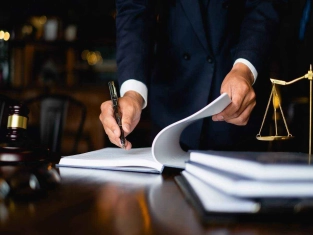by PushtoLearn
Unit 14 - Debtor-creditor
Table of Contents
Unit 14, International Legal English Exercises and Flashcards
These exercises focus on Unit 14, International Legal English
Wordlist for Unit 14, International Legal English
|
Word |
Definition |
Example |
|
consensual lien |
a lien created by agreement between the parties |
The consensual lien was created when the borrower agreed to use their car as collateral for the auto loan |
|
judicial lien |
a lien created as the result of a legal process |
The court issued a judicial lien against the debtor's property to enforce the payment of a judgment in favor of the creditor |
|
statutory lien |
a lien created by legislation governing the relationship between debtor and creditor |
A statutory lien automatically arises under specific laws, such as tax liens imposed by the government on delinquent taxpayers |
|
priority creditor |
A creditor who holds a higher-ranking or preferred claim to the assets or funds of a debtor over other creditor |
The priority creditor held a superior claim to the debtor's assets, ensuring they would be first in line for repayment during insolvency |
|
first-in-time |
A principle or rule that gives priority to the creditor or party who first establishes a claim or lien on a particular asset or property |
In lien disputes, the first-in-time principle often determines the priority of creditors, with the earliest lien taking precedence |
|
general creditor |
A creditor who does not possess a specific, priority claim or lien on a debtor's assets and is treated equally with other creditors in the event of the debtor's insolvency |
General creditors have claims against the debtor's assets but do not possess specific liens or priority status like secured creditors |
|
lien creditor |
A creditor who holds a claim secured by a lien, which is a legal right or interest in specific property or assets of the debtor as collateral for the repayment of a debt |
The lien creditor sought legal action to establish their claim over the property, asserting their right to seize it for debt satisfaction |
|
attachment lien |
a prejudgment interest in assets resulting from a court order or writ to seize such assets |
An attachment lien is placed on a debtor's property before a judgment is obtained, securing the potential judgment creditor's interest |
|
execution lien |
a right created by a court order or writ directing the seizure of assets of a debtor in order to enforce a judgment |
The execution lien allowed the judgment creditor to seize and sell the debtor's property to satisfy the outstanding judgment amount |
|
garnishment |
a claim in which a creditor requests a court to order a third party holding property of the debtor to release the relevant property to the creditor |
The court ordered garnishment of the defendant's wages, redirecting a portion of their income to satisfy an outstanding judgment |
|
judgment lien |
a claim imposed on a person against whom a judgment has been entered but remains unsatisfied |
The judgment lien recorded against the debtor's real estate served as notice of the unpaid judgment and potential property seizure |
|
mechanic's lien |
a claim against real property which secures payment for work or services carried out on that property |
The mechanic's lien ensured that the construction company would be paid for the renovation work completed on the homeowner's property |
|
mortgage |
a legal instrument which creates a claim upon real estate in order to secure the payment of a debt |
The mortgage agreement allowed the homebuyer to secure financing for the house, with the property serving as collateral for the loan |
|
security interest |
a legal right to property an owner gives to a creditor as collateral for repayment of a debt through the creation of a security agreement |
The security interest in the equipment granted the lender the right to repossess it if the borrower defaulted on the loan |
|
tax lien |
a claim against property which secures payment for taxes owed to the government |
The tax lien was imposed on the property by the government due to unpaid property taxes, giving the government a claim to the property |
|
to harass the defendant |
To engage in repeated and unwanted actions or communications directed toward the defendant in a legal case |
The attorney was cautioned not to harass the defendant during the legal proceedings but to maintain a professional and respectful demeanor |
|
to serve the process of law on someone |
To deliver legal documents, such as summons or subpoenas, to an individual or entity as part of the formal legal process |
The sheriff's deputy was tasked with serving the process of law on the defendant, delivering the court summons and related legal documents to ensure they were properly notified of the pending lawsuit |
|
to dispose of property with the intent to defraud creditors |
To transfer, sell, or convey one's property or assets with the purpose of hindering or evading the claims of creditors |
Intending to defraud creditors, the individual attempted to dispose of their valuable assets to prevent them from being seized in bankruptcy |
|
to obtain property under false pretences |
To acquire or receive property by using deceitful or dishonest means, often involving misleading or false statements or actions to gain possession |
The scam artist fraudulently obtained property under false pretences, convincing the victim to transfer ownership without legal justification |
|
insolvency |
The financial state in which an individual or entity is unable to meet their financial obligations and repay their debts, often leading to financial distress |
The company's financial statements revealed a state of insolvency, indicating that its liabilities exceeded its assets, potentially leading to bankruptcy |
|
legal regime |
statutory framework |
The legal regime governing intellectual property rights provided creators with protections against unauthorized use of their work |
|
fresh funds |
new loans |
The infusion of fresh funds from investors helped the struggling startup cover its operating expenses and continue its business operations |
|
equity |
assets of a company less its liabilities |
The court ordered the division of assets based on principles of equity, ensuring a fair and just distribution among the parties involved |
|
onerous |
difficult |
The onerous contract placed a heavy burden on the debtor, requiring substantial payments and obligations that were difficult to meet |

FAQ
What is the difference between a consensual lien, a judicial lien, and a statutory lien?
-
A consensual lien is a voluntary agreement where a debtor grants a creditor a security interest in property (e.g., a mortgage).
-
A judicial lien is imposed by a court, often after a creditor wins a lawsuit against a debtor.
-
A statutory lien is created by law, such as a tax lien or a mechanic’s lien, to secure unpaid obligations.
What is a priority creditor?
A priority creditor is a creditor whose claims are legally ranked higher than others, allowing them to be paid first in cases of insolvency or asset liquidation.
What does “first-in-time” mean in creditor law?
The first-in-time rule states that the first creditor to properly secure their lien or interest typically has priority over later creditors.
Who is considered a general creditor?
A general creditor is an unsecured creditor who has no specific claim to the debtor’s property and is paid only after secured creditors in bankruptcy.
What is a lien creditor?
A lien creditor is a creditor with a legal right to seize and sell a debtor’s property due to an unpaid debt.
What is an attachment lien?
An attachment lien is a court-ordered lien that freezes a debtor’s assets while a lawsuit is ongoing to prevent asset disposal.
What is an execution lien?
An execution lien allows a creditor to seize and sell a debtor’s property following a court judgment.
What is garnishment in debtor-creditor law?
Garnishment is a legal process where a creditor collects debt by taking funds directly from a debtor’s wages or bank account.
What is a judgment lien?
A judgment lien is created when a court ruling grants a creditor the right to place a lien on a debtor’s property to secure payment.
What is a mechanic’s lien?
A mechanic’s lien is a legal claim by contractors or suppliers against property for unpaid construction or repair work.
What is a tax lien?
A tax lien is a government claim against a debtor’s property for unpaid taxes.
What does it mean to “harass the defendant” in a debt collection case?
Harassing the defendant refers to illegal or excessive debt collection tactics that violate consumer protection laws.
What does it mean to “serve the process of law on someone”?
To serve the process of law means to formally deliver legal documents (e.g., a summons or court order) to a party in a legal case.
What does it mean to dispose of property with the intent to defraud creditors?
This refers to illegally transferring, hiding, or selling assets to prevent creditors from collecting what they are owed.
What does it mean to obtain property under false pretenses?
Obtaining property under false pretenses means acquiring assets through deception, fraud, or misrepresentation.
What is insolvency?
Insolvency occurs when an individual or business cannot pay debts as they become due. It often leads to bankruptcy proceedings.
What is the legal regime in debtor-creditor law?
A legal regime refers to the system of laws, regulations, and procedures governing debtor-creditor relationships.
What are fresh funds?
Fresh funds refer to new financing or capital obtained by a debtor, often to help manage existing debt or continue business operations.
What is equity in the context of debtor-creditor law?
Equity refers to the remaining value of an asset after subtracting outstanding debts or liens.
What does onerous mean in debtor-creditor agreements?
Onerous means burdensome or excessively difficult, often referring to debt terms or financial obligations that are hard to fulfill.

